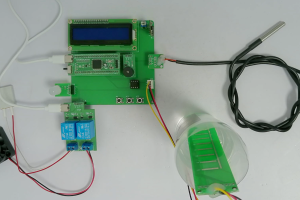设计说明书
总字数:18000+
摘要: 在快节奏的现代生活中,人们常常因为忙碌而忽视了基本的健康习惯,比如定时饮水。为了改善这一状况,智能保温杯应运而生,不仅能够提醒用户定时饮水,还能保持饮品在最佳温度,从而提升生活质量和健康水平。
本次设计的智能保温杯的设计基于单片机,集成了温度传感器和通信技术,能够实时监控水温并根据设定的参数提醒用户饮水。DS18B20温度传感器,负责精确检测水温,并根据用户的设定自动调节加热或制冷,以保持饮品在理想的温度范围内。此外,保温杯内置定时器,可以设定饮水间隔,并通过声光报警的方式提醒用户及时补充水分。用户还可以根据个人需求设置温度阈值和饮水间隔,系统会通过蓝牙技术将实时数据传输到用户的手机上,方便用户随时查看和调整设置。
旨在帮助用户建立科学的饮水习惯,确保及时补充水分,提高用户的健康意识。
关键词:智能保温杯;单片机;水温;蓝牙
Abstract: In the fast-paced modern life, people often neglect basic health habits, such as regular drinking water. In order to improve this situation, the smart thermos cup came into being, not only reminding users to drink water regularly, but also to keep the drink at the best temperature, so as to improve the quality of life and health level.
The design of the intelligent vacuum cup is based on the single chip controller, integrating the temperature sensor and communication technology, which can monitor the water temperature in real time and remind users of drinking water according to the set parameters. DS18B20 Temperature sensor, responsible for accurate detection of water temperature, and automatically adjust the heating or cooling according to the user’s setting, to keep the drink in the ideal temperature range. In addition, the thermos cup has a built-in timer, which can set the drinking water interval, and remind users to replenish water in time through sound and light alarm. Users can also set the temperature threshold and drinking water interval according to their personal needs, and the system will transmit real-time data to the user’s mobile phone through Bluetooth technology, so that users can view and adjust the Settings at any time.
It aims to help users establish scientific drinking habits, ensure timely hydration, and improve users’ health awareness.
Keywords: Smart vacuum cup; single-chip microcontroller; water temperature; Bluetooth
目 录
1 前 言
1.1课题的来源及意义
1.1.1课题来源
1.1.2课题意义
1.2课题国内外研究现状
1.2.1国外研究现状
1.2.2国内研究现状
1.3课题内容
1.3.1 课题内容概述
1.3.2 课题存在问题
1.3.3 课题应解决的问题
2 课题主体及方案选型
2.1 系统框图设计
2.2 各模块的选型
2.2.1 主控模块选型
2.2.2 温度检测模块选型
2.2.3 无线通信模块选型
2.2.4 显示模块选型
3 硬件电路设计
3.1 主控模块电路设计
3.2 温度检测模块电路设计
3.3 液位检测模块电路设计
3.4 A/D电路转换模块电路设计
3.5 RGB灯模块电路设计
3.6 蓝牙模块电路设计
3.7 按键模块电路设计
3.8 显示模块电路设计
3.9 执行器模块电路设计
4 软件流程设计
4.1 编程软件介绍
4.2 系统主流程设计
4.3 独立按键
4.4温度检测模块子流程
4.5 A/D模数转换子流程
4.6 蓝牙模块子流程
5 实物测试
5.1 实物展示
5.2 过程测试
6 结 论
参考文献
致 谢
附录1 原理图
附录2 程序
购买后可查看具体内容!

